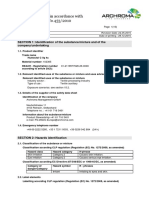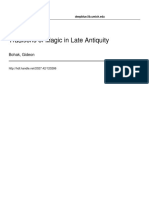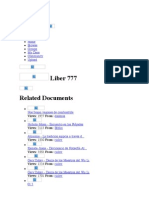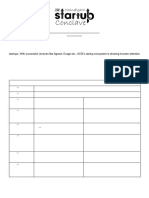Heqet PDF
Heqet PDF
Uploaded by
manuelCopyright:
Available Formats
Heqet PDF
Heqet PDF
Uploaded by
manuelOriginal Description:
Original Title
Copyright
Available Formats
Share this document
Did you find this document useful?
Is this content inappropriate?
Copyright:
Available Formats
Heqet PDF
Heqet PDF
Uploaded by
manuelCopyright:
Available Formats
Heqet
To the Egyptians, the frog was a symbol of life and fertility, since millions of them were born after the annual
inundation of the Nile, which brought fertility to the otherwise barren lands. Consequently, in Egyptian mythology, there began to be a frog-goddess, who represented
fertility, referred to by Egyptologists as Heqet (also
Heqat, Hekit, Heket etc., more rarely Hegit, Heget
etc.),[1] written with the determinative frog.[2]
germination of corn, she became associated with the nal stages of childbirth. This association, which appears
to have arisen during the Middle Kingdom, gained her the
title She who hastens the birth.[6] Some claim thateven
though no ancient Egyptian term for midwife is known
for certainmidwives often called themselves the Servants of Heqet, and that her priestesses were trained in
midwifery.[7] Women often wore amulets of her during
childbirth, which depicted Heqet as a frog, sitting in a
lotus.
Heqet was considered the wife of Khnum, who formed
the bodies of new children on his potters wheel.[8]
Name and depiction
Her name was probably pronounced more like *aqtat
in Middle Egyptian, hence her later Greek counterpart
(see Hecate).[3] Heqet was usually depicted as a
frog, or a woman with a frogs head, or more rarely as
a frog on the end of a phallus to explicitly indicate her
association with fertility. She was often referred to as the
wife of Khnum.[4]
In the myth of Osiris developed, it was said that it was
Heqet who breathed life into the new body of Horus at
birth, as she was the goddess of the last moments of birth.
As the birth of Horus became more intimately associated
with the resurrection of Osiris, so Heqets role became
one more closely associated with resurrection. Eventually, this association led to her amulets gaining the phrase
I am the resurrection in the Christian era along with cross
and lamb symbolism.[9]
A temple dedicated to Horus and Heqet dating to the
Ptolemaic Period was found at Qus.[10][11]
Worship of Heqet
3 Footnotes
[1] Armour, op.cit., p.116
[2] Erman, op.cit. vol. 3, 169.10
[3] McKechnie, Paul, and Philippe Guillaume. Ptolemy II
Philadelphus and His World. Leiden: Brill, 2008. page
133.
[4] Cotterell, op.cit., p.213
[5] Wilkinson, Toby, p. 286
The god Khnum, accompanied by Heqet, moulds Ihy in a relief
from the mammisi (birth temple) at Dendera Temple complex,
Dendara, Egypt
[6] cf. the role of Heqet in the story of The Birth of the Royal
Children from the Westcar Papyrus. Lichtheim, op.cit.
p.220
The beginning of her cult dates to the early dynastic period at least. Her name was part of the names of some
high-born Second Dynasty individuals buried at Helwan
and was mentioned on a stela of Wepemnofret and in the
Pyramid Texts. Early frog statuettes are often thought to
be depictions of her.[5]
[7] Franklin, op.cit., p.86
[8] Wilkinson, Richard H. (2003). The Complete Gods and
Goddesses of Ancient Egypt. Thames & Hudson. p. 229
[9] Shier, Louise A. (1972). The Frog on Lamps from Karanis. Medieval and Middle Eastern Studies (Brill). p. 357.
Later, as a fertility goddess, associated explicitly with the [10] Porter, Bertha and Moss, Rosalind. Topographical Biblilast stages of the ooding of the Nile, and so with the
ography of Ancient Egyptian Hieroglyphic Texts, Reliefs
1
and Paintings, V Upper Egypt: Sites (Volume 5). Grith
Institute. 2004.
[11] Wilkinson, Richard H., The Complete Temples of Ancient Egypt, Thames and Hudson, 2000, pp 152, ISBN
0-500-05100-3
References
Robert A. Armour, Gods and Myths of Ancient
Egypt, American Univ. in CairoPress 2001
Erman, Johann Peter Adolf, and Hermann Grapow,
eds. 19261953. Wrterbuch der aegyptischen
Sprache im Auftrage der deutschen Akademien. 6
vols. Leipzig: J. C. Hinrichsschen Buchhandlungen. (Reprinted Berlin: Akademie-Verlag GmbH,
1971).
Arthur Cotterell, The Macmillan Illustrated Encyclopedia of Myths & Legends, Macmillan 1989
Toby A. H. Wilkinson, Early Dynastic Egypt, Routledge 1999
Rosalind Franklin, Baby Lore: Superstitions and Old
Wives Tales from the World Over Related to Pregnancy, Birth and Babycare, Diggory Press 2005
M. Lichtheim, Ancient Egyptian Literature, Vol.1,
1973
REFERENCES
Text and image sources, contributors, and licenses
5.1
Text
Heqet Source: https://en.wikipedia.org/wiki/Heqet?oldid=667156440 Contributors: Looxix~enwiki, TUF-KAT, Charles Matthews,
Moink, Gtrmp, Cronos~enwiki, Eequor, Grm wnr, CALR, Rich Farmbrough, Kwamikagami, Grutness, Deacon of Pndapetzim, Garzo,
-Ril-, FlaBot, Margosbot~enwiki, YurikBot, GeeJo, Orioane, SmackBot, Unyoyega, Od Mishehu, Gilliam, A. Parrot, Sobreira, Cynwolfe,
.anacondabot, T@nn, Andi d, MartinBot, Ian.thomson, 83d40m, VolkovBot, TXiKiBoT, A4bot, AnnekeBart, SieBot, Ptolemy Caesarion,
Gits (Neo), SuperHamster, Mikaey, DFN, Addbot, Vatrena ptica, Feour, Favonian, Zorrobot, Luckas-bot, Yobot, Ptbotgourou, Xqbot,
LucienBOT, I dream of horses, Tahir mq, Dmthoth, Tibetan Prayer, Lotje, WikitanvirBot, Mychele Trempetich, ClueBot NG, Kasirbot,
Titodutta, Davidiad, Voxelhound, Haymouse and Anonymous: 26
5.2
Images
File:Aker.svg Source: https://upload.wikimedia.org/wikipedia/commons/1/1c/Aker.svg License: GFDL Contributors: Own work Original
artist: Je Dahl
File:Ancient_Egypt_Wings.svg Source: https://upload.wikimedia.org/wikipedia/commons/9/9e/Ancient_Egypt_Wings.svg License:
GFDL Contributors: This vector image was created with Inkscape by Je Dahl. Original artist: Je Dahl
File:Commons-logo.svg Source: https://upload.wikimedia.org/wikipedia/en/4/4a/Commons-logo.svg License: ? Contributors: ? Original
artist: ?
File:DendaraMamisiKhnum-10.jpg Source: https://upload.wikimedia.org/wikipedia/commons/4/43/DendaraMamisiKhnum-10.jpg
License: CC BY-SA 3.0 Contributors: Own work (Original text: self-made) Original artist: Roland Unger
File:Djed.svg Source: https://upload.wikimedia.org/wikipedia/commons/f/fe/Djed.svg License: GFDL Contributors: Own work Original
artist: Je Dahl
File:Kheper.svg Source: https://upload.wikimedia.org/wikipedia/commons/2/24/Kheper.svg License: GFDL Contributors: Own work
Original artist: Je Dahl
File:Pyramide_Kheops.JPG Source: https://upload.wikimedia.org/wikipedia/commons/5/56/Pyramide_Kheops.JPG License: CC-BYSA-3.0 Contributors: Own work Original artist: Alex lbh
File:Symbol_book_class2.svg Source: https://upload.wikimedia.org/wikipedia/commons/8/89/Symbol_book_class2.svg License: CC
BY-SA 2.5 Contributors: Mad by Lokal_Prol by combining: Original artist: Lokal_Prol
5.3
Content license
Creative Commons Attribution-Share Alike 3.0
You might also like
- Humectol C Liq HC - MSDSDocument10 pagesHumectol C Liq HC - MSDSJaleel AhmedNo ratings yet
- Picatrix (The Aim of The Sage)Document21 pagesPicatrix (The Aim of The Sage)خوان لوئیس کاماچو جردو50% (2)
- Heinrich Ignaz Franz BiberDocument7 pagesHeinrich Ignaz Franz Bibermanuel100% (1)
- Cylinder Seal PDFDocument6 pagesCylinder Seal PDFmanuelNo ratings yet
- HermopolisDocument36 pagesHermopolissoy yo o noNo ratings yet
- Hieroglyphic Texts F R o M Egyptian Stelae-, Part 12, Edited B y M.L. Bierbrier, British Museum PressDocument3 pagesHieroglyphic Texts F R o M Egyptian Stelae-, Part 12, Edited B y M.L. Bierbrier, British Museum PressKıvanç TatlıtuğNo ratings yet
- The Dragon and The PhoenixDocument3 pagesThe Dragon and The PhoenixVietnam Heritage TravelNo ratings yet
- GD Correspondence Course Lessons 047 To 050Document58 pagesGD Correspondence Course Lessons 047 To 050Welder OliveiraNo ratings yet
- An Esoteric Interpretation of The Narmer Palette and The Narmer Mace HeadDocument25 pagesAn Esoteric Interpretation of The Narmer Palette and The Narmer Mace HeadDrDAW100% (3)
- B.1 Competency-Based Curriculum (TESDA-OP-CO-01-F11)Document42 pagesB.1 Competency-Based Curriculum (TESDA-OP-CO-01-F11)Richard DuranNo ratings yet
- Ever Since Man First Noticed The Regular Movement of The Sun and The StarsDocument9 pagesEver Since Man First Noticed The Regular Movement of The Sun and The StarsRohit PrakashNo ratings yet
- Traditions of Magic 96Document21 pagesTraditions of Magic 96eannatumNo ratings yet
- Heqet The Frog GoddessDocument2 pagesHeqet The Frog GoddessSadhvi MaatNo ratings yet
- Chaos in Ancient Egypt GM 257 2019 25-36 PDFDocument12 pagesChaos in Ancient Egypt GM 257 2019 25-36 PDFsoha elmahdyNo ratings yet
- Ritual Ancient EgyptDocument11 pagesRitual Ancient EgyptEdson PimentaNo ratings yet
- Ereshkigal: EREŠ - KI.GAL, Lit. "Queen of The Great Earth")Document5 pagesEreshkigal: EREŠ - KI.GAL, Lit. "Queen of The Great Earth")Edwin100% (1)
- A Prayer To SeshatDocument1 pageA Prayer To SeshatPoorya BagherpoorNo ratings yet
- 10 Interesting Facts About Ancient EgyptDocument5 pages10 Interesting Facts About Ancient EgyptDiana LarisaNo ratings yet
- Outline of Sahidic Coptic MorphologyDocument18 pagesOutline of Sahidic Coptic MorphologyClaude DetienneNo ratings yet
- Amun The Egyptian GodDocument9 pagesAmun The Egyptian GodJames DriscollNo ratings yet
- AmunetDocument8 pagesAmunetmostraangelviannaNo ratings yet
- A Preliminary Inventory of The Arabic HermeticaDocument2 pagesA Preliminary Inventory of The Arabic HermeticaRick RockNo ratings yet
- Greek Letter MeaningsDocument2 pagesGreek Letter Meaningssean griffinNo ratings yet
- Egyptian VocabularyDocument8 pagesEgyptian VocabularyKantnatt CharatcharoenwitthayaNo ratings yet
- Leprohon, Egyptian Religious TextsDocument25 pagesLeprohon, Egyptian Religious TextsAnonymous 5ghkjNx100% (2)
- HydromancyDocument6 pagesHydromancyScribdTranslationsNo ratings yet
- Fynes, Isis & Pattini (1993)Document16 pagesFynes, Isis & Pattini (1993)kamakarmaNo ratings yet
- 5 Fold GoddessDocument3 pages5 Fold GoddessValentina Ramos100% (1)
- Epithets of Bast IncompDocument3 pagesEpithets of Bast IncompDaymonDrakon100% (2)
- YamProt-Wheel Discuss OverviewDocument1 pageYamProt-Wheel Discuss Overviewgarudasky21No ratings yet
- The Secret Behind Magic Circles: 2 Q 2 Q 2 Q 2 Q 3 Q 2 Q 3 Q 3 QDocument1 pageThe Secret Behind Magic Circles: 2 Q 2 Q 2 Q 2 Q 3 Q 2 Q 3 Q 3 QCorreo ColeguitasNo ratings yet
- S00006-Glowing Stones in Ancient and Medieval LoreDocument16 pagesS00006-Glowing Stones in Ancient and Medieval LorerippvannNo ratings yet
- Platos X and Hekates Crossroads Astronom PDFDocument8 pagesPlatos X and Hekates Crossroads Astronom PDFVeštičja revija100% (1)
- Glossary of Ancient Egyptian Terms and NamesDocument39 pagesGlossary of Ancient Egyptian Terms and NamesDjuraNo ratings yet
- Hieroglyphs Dictionary by Leonardo Vieira PDFDocument387 pagesHieroglyphs Dictionary by Leonardo Vieira PDFMarco HeinemannNo ratings yet
- Egypt: The Baboons and Monkeys of Ancient EgyptDocument11 pagesEgypt: The Baboons and Monkeys of Ancient EgyptSheltak100% (1)
- Kah BlablaDocument22 pagesKah Blablathaihuy15a2100% (1)
- Magical AlfabetDocument297 pagesMagical AlfabetLeaRninG3No ratings yet
- Iniciações Do Sacerdotes Egipcios Crata RepoaDocument30 pagesIniciações Do Sacerdotes Egipcios Crata RepoaMaria Joao SacagamiNo ratings yet
- Greek Gods and GoddessessDocument22 pagesGreek Gods and GoddessessOwii De LeonNo ratings yet
- A Tour of Atlantis: or What Happens in The Astral RealmDocument56 pagesA Tour of Atlantis: or What Happens in The Astral RealmWayne O'BoogieNo ratings yet
- Foreword To Epistles 1-2 of Rasa'il of Brethren of PurityDocument9 pagesForeword To Epistles 1-2 of Rasa'il of Brethren of PurityShahid.Khan1982No ratings yet
- Plato's AstronomyDocument7 pagesPlato's AstronomyKATPONSNo ratings yet
- Books On Astrology, Astronomical Tables, and Almanacs in The Library Inventory of Bayezid IIDocument55 pagesBooks On Astrology, Astronomical Tables, and Almanacs in The Library Inventory of Bayezid IIИван ЯкимчукNo ratings yet
- FOI Homepage - Online Liturgy: Booklet: by Olivia RobertsonDocument5 pagesFOI Homepage - Online Liturgy: Booklet: by Olivia RobertsonskaluNo ratings yet
- Hornblower - Osiris and His Rites IIDocument10 pagesHornblower - Osiris and His Rites IIFélixFernándezPalacioNo ratings yet
- Divine EpithetsDocument12 pagesDivine EpithetsAngelo_Colonna100% (3)
- Ibn Al-Nadim, Chapter On MagicDocument6 pagesIbn Al-Nadim, Chapter On Magicrick_rock_5No ratings yet
- The Egyptian Coffin Texts by Adriaan de BuckDocument416 pagesThe Egyptian Coffin Texts by Adriaan de BuckPoet In Japan100% (1)
- The Brilliant Apollo, Patron of Arts, Medicine and Prophecy - Dr. Guillermo Calvo SorianoDocument66 pagesThe Brilliant Apollo, Patron of Arts, Medicine and Prophecy - Dr. Guillermo Calvo Sorianosupremo7No ratings yet
- Sexuality in Ancient EgyptDocument8 pagesSexuality in Ancient EgyptmauricioelvisNo ratings yet
- Viziers PDFDocument22 pagesViziers PDFÉmän Hâmzá100% (1)
- The Book of The Zodiac DrowerDocument113 pagesThe Book of The Zodiac DrowerRagil Satrio NNo ratings yet
- Coffin TextsDocument3 pagesCoffin TextsNabil RoufailNo ratings yet
- Liber 777Document6 pagesLiber 777anon-337742No ratings yet
- Abyzou - WikipediaDocument2 pagesAbyzou - WikipediaNyx Bella DarkNo ratings yet
- The Book of Ba: RWB HollandDocument70 pagesThe Book of Ba: RWB Hollandhar58100% (1)
- Leiden University / Институт языкознания РАН, Москва: AVŚ 19.53-54 = AVP (Or.) 11.8-9 Hymn to Time (Kālasūkta)Document20 pagesLeiden University / Институт языкознания РАН, Москва: AVŚ 19.53-54 = AVP (Or.) 11.8-9 Hymn to Time (Kālasūkta)Kashyapa MNo ratings yet
- History of Egypt, Chaldea, Syria, Babylonia, and Assyria, Vol. 3From EverandHistory of Egypt, Chaldea, Syria, Babylonia, and Assyria, Vol. 3No ratings yet
- POLOXIA 2 - Polaxia-2Document1 pagePOLOXIA 2 - Polaxia-2manuelNo ratings yet
- Sirba Bran SirbadelabranDocument2 pagesSirba Bran SirbadelabranmanuelNo ratings yet
- SIRBA BATUTA Sarba - BatutaDocument1 pageSIRBA BATUTA Sarba - BatutamanuelNo ratings yet
- Alunelul de La Orodel: Rumänien / OlteniaDocument1 pageAlunelul de La Orodel: Rumänien / OlteniasoporanNo ratings yet
- Sirba Belcesti 2 - Sirbadelabelcesti - DMDocument1 pageSirba Belcesti 2 - Sirbadelabelcesti - DMmanuelNo ratings yet
- SIRBA MUNTENEASCA Sirba - MunteneascaDocument1 pageSIRBA MUNTENEASCA Sirba - MunteneascamanuelNo ratings yet
- SIRBA ZARNESTENILOR 1 - SirbaZarnestenilor PDFDocument2 pagesSIRBA ZARNESTENILOR 1 - SirbaZarnestenilor PDFmanuelNo ratings yet
- Partitions Roumanie PAHARELUL PaharelulDocument1 pagePartitions Roumanie PAHARELUL PaharelulmanuelNo ratings yet
- Partitions-roumanie-POLOXIA BARCA - Poloxia de La BarcaDocument1 pagePartitions-roumanie-POLOXIA BARCA - Poloxia de La BarcamanuelNo ratings yet
- Ana LugojanaDocument1 pageAna LugojanajuanNo ratings yet
- Partitions Roumanie COCONITA CoconitaDocument5 pagesPartitions Roumanie COCONITA CoconitamanuelNo ratings yet
- Partitions Roumanie HUTULCA HutulcaDocument3 pagesPartitions Roumanie HUTULCA Hutulcamanuel100% (1)
- Partitions Roumanie CA BREAZA 1 CA La Breaza MuntenieDocument3 pagesPartitions Roumanie CA BREAZA 1 CA La Breaza MunteniemanuelNo ratings yet
- Partitions-roumanie-HORA BALTI - Hora de La BaltiDocument1 pagePartitions-roumanie-HORA BALTI - Hora de La BaltimanuelNo ratings yet
- Libyan Desert GlassDocument16 pagesLibyan Desert GlassmanuelNo ratings yet
- Ragamala Paintings PDFDocument1 pageRagamala Paintings PDFmanuelNo ratings yet
- Saturn's Hexagon PDFDocument3 pagesSaturn's Hexagon PDFmanuelNo ratings yet
- Romania: Physical Activity Factsheet 2018Document4 pagesRomania: Physical Activity Factsheet 2018Andreea OneataNo ratings yet
- Flow Losses in Flexible Hose.Document186 pagesFlow Losses in Flexible Hose.Anonymous K3FaYFlNo ratings yet
- CT SS For Student Apr2019Document5 pagesCT SS For Student Apr2019Nabila RosmizaNo ratings yet
- Programme Chandigarh Startup Conclave Friday 23rd August 2024 CII ChandigarhDocument4 pagesProgramme Chandigarh Startup Conclave Friday 23rd August 2024 CII Chandigarhmk4522985No ratings yet
- Zafira Rear Door WiresDocument3 pagesZafira Rear Door WiresPaulo RochaNo ratings yet
- Eram Sem 2021 Uk MelDocument32 pagesEram Sem 2021 Uk Meltaufiq_hidayat_1982No ratings yet
- PDF Crazy Quilting The Complete Guide 1st Edition J Marsha Michler downloadDocument81 pagesPDF Crazy Quilting The Complete Guide 1st Edition J Marsha Michler downloadsadwitunce100% (5)
- Long Term Investment StrategiesDocument4 pagesLong Term Investment Strategiesskabdurrahman2014No ratings yet
- Adaptive Traffic Light Control SystemDocument15 pagesAdaptive Traffic Light Control SystemSadaf TajNo ratings yet
- 5MBDocument107 pages5MBPascar Ioan100% (1)
- Anti Aircraft Materiel For The MG'sDocument168 pagesAnti Aircraft Materiel For The MG'sJose Luis Castillo100% (1)
- Fundations LessonsDocument3 pagesFundations Lessonsapi-634427929No ratings yet
- The Early National PeriodDocument20 pagesThe Early National PeriodEunice GarridoNo ratings yet
- Effekt ProfileDocument35 pagesEffekt ProfilemilanatanaskovicNo ratings yet
- Introduction To Cuisine of The WorldDocument8 pagesIntroduction To Cuisine of The WorldJayeelleNo ratings yet
- General Notes and Specifications For Structural Works (Issued As A Supplement To The Structural Plans)Document12 pagesGeneral Notes and Specifications For Structural Works (Issued As A Supplement To The Structural Plans)Brian SantosNo ratings yet
- en_2024t411Document12 pagesen_2024t411jeancarlosmantillarNo ratings yet
- Grade 10 Third Quarter Test QuestionDocument2 pagesGrade 10 Third Quarter Test Questionjhun bagain75% (4)
- Phar1101 James Holmsen 21512634Document6 pagesPhar1101 James Holmsen 21512634James HompsanNo ratings yet
- TALKING ELECTRONICS 555 Page1Document11 pagesTALKING ELECTRONICS 555 Page1Eugene FlexNo ratings yet
- Structur Assesment Project Planner TargetDocument1 pageStructur Assesment Project Planner TargetIwan PhpNo ratings yet
- Office of The Principal, Government Polytecnic College, Harda (M.P.) 461-331Document1 pageOffice of The Principal, Government Polytecnic College, Harda (M.P.) 461-331Shubham AgrawalNo ratings yet
- JohnKellyAwards2023 - Celia O'SheaDocument7 pagesJohnKellyAwards2023 - Celia O'SheaAlsonNo ratings yet
- Fragments From ChronosDocument172 pagesFragments From ChronosJimNo ratings yet
- Booklist Y8: Pakistan International School Jeddah - English Section Academic Session 2020-2021Document1 pageBooklist Y8: Pakistan International School Jeddah - English Section Academic Session 2020-2021FAREEDNo ratings yet
- Campy Creatures Solo Variant v2.0Document5 pagesCampy Creatures Solo Variant v2.0Toni SolisNo ratings yet
- 1T00918Document2 pages1T00918Clovis MachadoNo ratings yet
- Download full A Theory of Global Governance: Authority, Legitimacy, and Contestation Michael Zurn ebook all chaptersDocument51 pagesDownload full A Theory of Global Governance: Authority, Legitimacy, and Contestation Michael Zurn ebook all chaptersrawalirvanua100% (2)












































































































